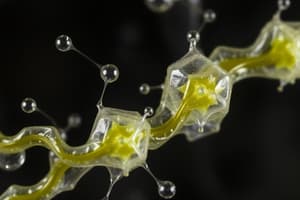Podcast
Questions and Answers
What is the primary function of carbohydrates in the diet?
What is the primary function of carbohydrates in the diet?
- Vital for healthy bones
- Provides a lot of energy (correct)
- Helps food pass through the digestive system
- Provides materials to repair tissues
Which food group is vital for making new cells and repairing damaged tissues?
Which food group is vital for making new cells and repairing damaged tissues?
- Lipids
- Vitamins
- Proteins (correct)
- Fibre
What is the primary role of enzymes in the digestive process?
What is the primary role of enzymes in the digestive process?
- To improve the taste of food
- To mechanically break down food
- To chemically break down food molecules (correct)
- To store nutrients for later use
What is the main role of water in the digestive system?
What is the main role of water in the digestive system?
Which enzyme is responsible for breaking down starch?
Which enzyme is responsible for breaking down starch?
Which of the following food groups is primarily supplied by fruit and vegetables?
Which of the following food groups is primarily supplied by fruit and vegetables?
Which component of the body is responsible for moving food with enzymes and acids?
Which component of the body is responsible for moving food with enzymes and acids?
What is a key function of vitamins in the human body?
What is a key function of vitamins in the human body?
What is the end result of chemical digestion?
What is the end result of chemical digestion?
Which enzyme would be most effective in breaking down fats?
Which enzyme would be most effective in breaking down fats?
What is one important safety practice to follow in the laboratory?
What is one important safety practice to follow in the laboratory?
Which of the following is NOT a piece of laboratory apparatus?
Which of the following is NOT a piece of laboratory apparatus?
What should you avoid doing during a practical lab session?
What should you avoid doing during a practical lab session?
Which safety measure involves careful use of lab tools?
Which safety measure involves careful use of lab tools?
What is the purpose of using a tripod stand in the lab?
What is the purpose of using a tripod stand in the lab?
What must happen for a chemical reaction to occur according to collision theory?
What must happen for a chemical reaction to occur according to collision theory?
How does increasing the surface area of a solid typically affect the reaction rate?
How does increasing the surface area of a solid typically affect the reaction rate?
Which of the following factors does NOT affect the rate of a chemical reaction?
Which of the following factors does NOT affect the rate of a chemical reaction?
What was the independent variable changed in the experiment?
What was the independent variable changed in the experiment?
What was measured as the dependent variable in this experiment?
What was measured as the dependent variable in this experiment?
In a teacher demonstration with sodium thiosulfate, what is being measured to determine the reaction speed?
In a teacher demonstration with sodium thiosulfate, what is being measured to determine the reaction speed?
What is the primary role of a catalyst in a chemical reaction?
What is the primary role of a catalyst in a chemical reaction?
How did the experiment ensure it was a fair test?
How did the experiment ensure it was a fair test?
What is a method to improve the reliability of the experiment's results?
What is a method to improve the reliability of the experiment's results?
What is the conclusion about the effect of temperature on reaction rates?
What is the conclusion about the effect of temperature on reaction rates?
What is the primary cause of malnutrition?
What is the primary cause of malnutrition?
Which nutrient deficiency is associated with rickets?
Which nutrient deficiency is associated with rickets?
What condition is often caused by a deficiency of iron?
What condition is often caused by a deficiency of iron?
What is the formula for calculating BMI?
What is the formula for calculating BMI?
Which of the following diseases is linked to inadequate calcium intake?
Which of the following diseases is linked to inadequate calcium intake?
What color indicates the presence of a large amount of sugar in food tests?
What color indicates the presence of a large amount of sugar in food tests?
Which part of the body is responsible for producing bile?
Which part of the body is responsible for producing bile?
What process is used to move food from the esophagus to the stomach?
What process is used to move food from the esophagus to the stomach?
Which enzyme is NOT produced by the pancreas?
Which enzyme is NOT produced by the pancreas?
What color change occurs when starch is present in a food test?
What color change occurs when starch is present in a food test?
What is the formula for calculating average speed?
What is the formula for calculating average speed?
What unit is used to measure average speed?
What unit is used to measure average speed?
If a vehicle travels a distance of 6000 meters in 400 seconds, what is its average speed?
If a vehicle travels a distance of 6000 meters in 400 seconds, what is its average speed?
What does a horizontal line on a distance-time graph indicate?
What does a horizontal line on a distance-time graph indicate?
How is the total stopping distance of a vehicle calculated?
How is the total stopping distance of a vehicle calculated?
What is the formula used to calculate speed?
What is the formula used to calculate speed?
Which of the following components is essential for hydration in the body?
Which of the following components is essential for hydration in the body?
What is the relationship between total stopping distance and other distances?
What is the relationship between total stopping distance and other distances?
Which nutrient is primarily responsible for providing energy?
Which nutrient is primarily responsible for providing energy?
Which vitamin is important for making bones and tissues healthy?
Which vitamin is important for making bones and tissues healthy?
How does an increase in temperature affect the rate of reaction?
How does an increase in temperature affect the rate of reaction?
What is the result of adding a metal to an acid?
What is the result of adding a metal to an acid?
Which statement correctly describes what happens to acid concentration and reaction rate?
Which statement correctly describes what happens to acid concentration and reaction rate?
What happens to the particles in a chemical reaction when a catalyst is used?
What happens to the particles in a chemical reaction when a catalyst is used?
Flashcards
Independent Variable
Independent Variable
The variable that is changed by the experimenter in an experiment.
Dependent Variable
Dependent Variable
The variable being measured in an experiment; the result or output.
Fair Test
Fair Test
An experiment where only one variable is changed at a time, keeping others constant.
Reliable Results
Reliable Results
Signup and view all the flashcards
Rate of Reaction
Rate of Reaction
Signup and view all the flashcards
Collision Theory
Collision Theory
Signup and view all the flashcards
Surface Area (reaction)
Surface Area (reaction)
Signup and view all the flashcards
Catalyst (reaction)
Catalyst (reaction)
Signup and view all the flashcards
Reaction Rate
Reaction Rate
Signup and view all the flashcards
Temperature Effect (reaction)
Temperature Effect (reaction)
Signup and view all the flashcards
Carbohydrates function
Carbohydrates function
Signup and view all the flashcards
Protein's role
Protein's role
Signup and view all the flashcards
Function of Vitamins
Function of Vitamins
Signup and view all the flashcards
Fiber's job
Fiber's job
Signup and view all the flashcards
Importance of Water
Importance of Water
Signup and view all the flashcards
Small Intestine
Small Intestine
Signup and view all the flashcards
Chemical Digestion
Chemical Digestion
Signup and view all the flashcards
Amylase
Amylase
Signup and view all the flashcards
Protease
Protease
Signup and view all the flashcards
Lipase
Lipase
Signup and view all the flashcards
Laboratory Safety
Laboratory Safety
Signup and view all the flashcards
Bunsen Burner
Bunsen Burner
Signup and view all the flashcards
Tripod Stand
Tripod Stand
Signup and view all the flashcards
Conical Flask
Conical Flask
Signup and view all the flashcards
Beaker
Beaker
Signup and view all the flashcards
Malnutrition
Malnutrition
Signup and view all the flashcards
Vitamin D Deficiency
Vitamin D Deficiency
Signup and view all the flashcards
Iron Deficiency
Iron Deficiency
Signup and view all the flashcards
BMI
BMI
Signup and view all the flashcards
Calcium Deficiency
Calcium Deficiency
Signup and view all the flashcards
Mouth function
Mouth function
Signup and view all the flashcards
Saliva's role
Saliva's role
Signup and view all the flashcards
Liver function
Liver function
Signup and view all the flashcards
Esophagus function
Esophagus function
Signup and view all the flashcards
Pancreas function
Pancreas function
Signup and view all the flashcards
Distance
Distance
Signup and view all the flashcards
Speed
Speed
Signup and view all the flashcards
Total Stopping Distance
Total Stopping Distance
Signup and view all the flashcards
Carbohydrates
Carbohydrates
Signup and view all the flashcards
Average Speed Equation
Average Speed Equation
Signup and view all the flashcards
Units for Speed
Units for Speed
Signup and view all the flashcards
Distance-Time Graph: Horizontal Line
Distance-Time Graph: Horizontal Line
Signup and view all the flashcards
Distance-Time Graph: Straight, Sloped Line
Distance-Time Graph: Straight, Sloped Line
Signup and view all the flashcards
Temperature's effect on reaction rate
Temperature's effect on reaction rate
Signup and view all the flashcards
Concentration's impact on reactions
Concentration's impact on reactions
Signup and view all the flashcards
What are catalysts?
What are catalysts?
Signup and view all the flashcards
Activation Energy & Catalysts
Activation Energy & Catalysts
Signup and view all the flashcards
What is a successful collision?
What is a successful collision?
Signup and view all the flashcards
Study Notes
Rates of Reaction - Exam Questions
- Conclusion - As the temperature increases, the rate of reaction also does.
- What was the independent variable that was changed in the experiment?
- The temperature of the reaction (water)
- What was the time taken for the dependent variable that was changed?
- The time taken for the reaction to happen.
- How was this a fair test?
- We used the same volume and concentration.
- What would you do to make sure your results are reliable?
- Repeat to find anomalies and find an average.
Studying That Suits You
Use AI to generate personalized quizzes and flashcards to suit your learning preferences.




